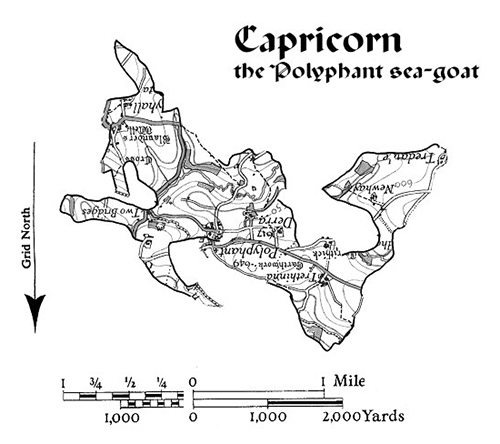
Capricorn
Polyphant, pronounced Pol’IF’ent, means toad’s or spring pool, it lies three quarters of a mile from the A30.
Capricorn is in an ocean-oriented part of the northern autumnal sky, along with Aquarius the water-carrier, the Whale, the Dolphin, the southern Fish and the two fish of the zodiac sign of Pisces. 2500 years ago the winter solstice occurred in the sign of Capricorn which was then a water sign. Records from around 600 BC describe the Sumerian vision of the world as a round plateau ringed with mountains which supported the domed sky. It floated on primordial water which broke through the earth’s surface as fresh water springs. The god Ea told the Uta-Napishtim to build an ark, in an earlier version of the biblical story of Noah. Ea emerged four times, at long intervals, in human form wearing a fish-tailed coat.

Almost every manufactured product spends some time in a shipping container, one of the important innovations of twentieth century logistics. Containers are subject to low regulatory or transactional friction and so achieve the fluidity of the sea-goat. The particular forms of container used throughout the history of shipping display substantial economic, class, and regulatory relations of dimensionality. Shorter containers, e.g. 10 foot containers, exist, but are rarely used. The 20 foot container is the most common container worldwide, but the 40 foot container is increasingly replacing it, particularly since costs tend to be charged per container and not per foot. I n a world where goods but not people are afforded maximum freedom of movement, it can sometimes be necessary to assume the qualities of a shipping container or sea-goat, or to hide inside one, in order to maximise mobilty.
The system of container shipping allowed for freight consolidating jobs to move from the waterfront to far inland, which decreased the number of waterfront jobs. The shipping container sea-goat becoming a shipping container land-goat implies exchange, trade, communality, a difference in state from water to earth. It implies that something is not individualised but composed in part by the necessity of relations. The sea-goat moves through increasingly smooth space, from land to sea, before being placed in airless space as an imagined connection of stars that form the operative geometry of the constellation. A shipping container, like a sea-goat, exemplifies in a particularly pure but different way a trajectory towards standardisation, not simply as an animal, or fish, but as a process.
bodmin moor zodiac index
buy the bodmin moor zodiac book
| Leo | Virgo | Libra | Scorpio |
| Sagittarius | Capricorn | Aquarius | Pisces |
| Taurus | Aries | Gemini | Cancer |